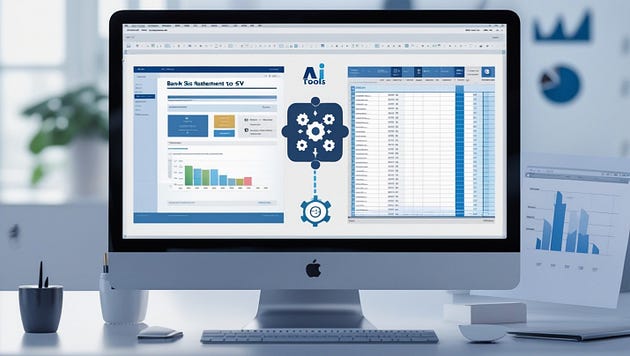How to Convert Bank Statements to CSV in Seconds Using AI Tools

In today’s fast-paced world, time is money. One of the most repetitive and error-prone tasks is converting bank statements from PDF to CSV to use in accounting software. Traditionally, this is done by manual data entry or tedious formatting. But in this era, with some AI-powered tools, such as Receipt Bot, it can now be automated and finished I, such as a matter of seconds
Why Convert Bank Statements to CSV?
CSV is the go-to format for importing transactional data into platforms like QuickBooks, Xero, or Excel. Since most bank statements are issued in PDF, especially scanned versions, they are not readily compatible with accounting systems.
Choosing the Right AI Tool
Not all PDF to CSV tools are built the same. Some are basic, which only read the text from simple layouts. Others do much more using artificial intelligence and machine learning to recognize patterns, clean up inconsistencies, and handle documents that would require lot of manual work. There are many tools available to convert PDFs to CSV, but ones that combine OCR (Optical Character Recognition) with machine learning to intelligently extract financial data.
One tool that’s been an attraction for accountants is Receipt Bot, which is specifically designed for handling financial documents like receipts, invoices, and bank statements. It is built to automatically recognize PDF bank statements into a CSV file. Here is what makes it different from others:
· It can process both digital and scanned PDFs.
· It recognizes different bank layouts automatically.
· Can easily upload them by email.
· It organizes transactions by date, description, and amount, ready for accounting software.
- It helps cut down on the repetitive data entry that slows down month-end work.
How to Convert Bank Statements to CSV: A Simple Guide
Here’s how the process typically works:
Step 1: Create an Account
Firstly, we need to set up an account in Receipt Bot, it gives you 30 credits free after creating an account.
Step 2: Upload the Statement
You can simply drag-and-drop documents, or you can upload by email forwarding too. With batch processing, you can handle multiple statements in one go.
Step 3: Automatic Data Extraction
It takes some time for the Receipt Bot to extract data from Bank & Card statements and perform verifications to ensure you get accurate results.
Step 4: Review and Confirm
Review the extracted data via the Receipt Bot interface.
Step 5: Export to CSV
Once confirmed, export your data as a CSV file. You can then import it directly into your accounting system or spreadsheet for further analysis or reporting.
A Faster, Smarter Way to Handle Bank Statements
Using AI tools to convert bank statements isn’t just about speed. It is also about reducing the chances of making mistakes and freeing up time for other tasks. Whether you’re managing your business finances or handling accounts for other clients, this kind of automation is a game-changer for Bookkeepers and accountants.
Tools like Receipt Bot are designed with accounting workflows in mind. It is not just a document converter, but it is a full system that can help in organizing, processing, and importing data with minimal friction.
Final Thoughts
If you’re still copying transactions by hand from PDFs into spreadsheets, now’s the time to stop. An AI tool like Receipt Bot makes it easy to convert bank statements into structured data. It handles hard parts like layout detection and data formatting, so you don’t have to. By reducing time spent on data extraction and minimizing errors, Receipt Bot helps to improve efficiency and data integrity. Whether you’re a solo accountant or part of a large finance team, incorporating smart automation into your workflow is a step toward smarter, faster, and more reliable financial operations.
Comments
Post a Comment